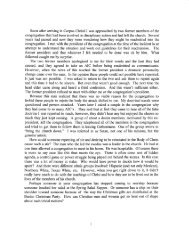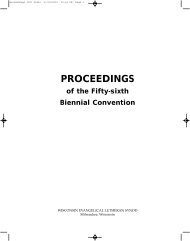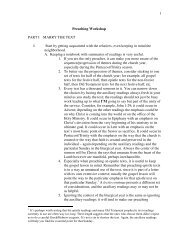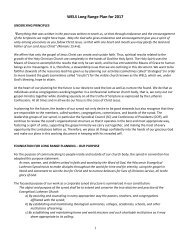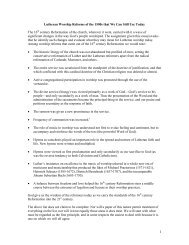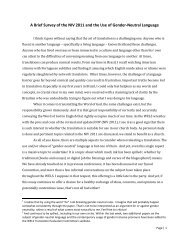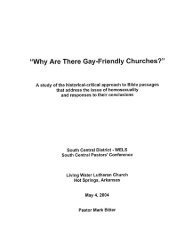A History of the WELS - The South Central District
A History of the WELS - The South Central District
A History of the WELS - The South Central District
Create successful ePaper yourself
Turn your PDF publications into a flip-book with our unique Google optimized e-Paper software.
10<br />
to build a new seminary. Look at <strong>the</strong> figures in <strong>the</strong> above news item (about <strong>the</strong> Augustana<br />
Synod) and ask yourself, should it not be an easy matter for our 140,000 communicants to raise<br />
<strong>the</strong> required amount?<br />
<strong>The</strong> Synod used <strong>the</strong> Northwestern Lu<strong>the</strong>ran to make special appeals to <strong>the</strong> member congregations for<br />
special collections. Here is one example:<br />
To every communicant <strong>of</strong> <strong>the</strong> Joint Synod: You are earnestly called upon for an <strong>of</strong>fering at<br />
Pentecost <strong>of</strong> One dollar—and more if possible—for <strong>the</strong> work in <strong>the</strong> Kingdom <strong>of</strong> God as carried<br />
on by our Synod. 24<br />
What prompted all this writing, especially writing <strong>of</strong> this nature? People, in general, were becoming more<br />
statistically minded. <strong>The</strong> government especially was concerned about statistics, statistics <strong>of</strong> all sorts, but mostly<br />
population and financial. For <strong>the</strong> Joint Synod <strong>of</strong> Wisconsin and o<strong>the</strong>r states <strong>the</strong> most important statistic was <strong>the</strong><br />
indebtedness <strong>of</strong> Synod, which was enormous, over $750,000, and continuing to grow.<br />
How did it get so bad?<br />
<strong>The</strong> Synod <strong>of</strong> 1921 had resolved to build a new seminary on a new site, and it was not to cost more<br />
than $500,000. In 1923 Synod began to collect for <strong>the</strong> new seminary. <strong>The</strong> 1923 Convention <strong>of</strong> Synod resolved<br />
that “<strong>The</strong> building <strong>of</strong> <strong>the</strong> new seminary shall not be begun until <strong>the</strong> present debts have been paid, and <strong>the</strong> full<br />
amount necessary for such building is at hand.” 25 <strong>The</strong>se present debts amounted to $289,508.05. <strong>The</strong> Seminary<br />
Building Fund was to be used not only for <strong>the</strong> building <strong>of</strong> <strong>the</strong> seminary, but also for <strong>the</strong> retirement <strong>of</strong> <strong>the</strong>se<br />
present debts. John Brenner was chairman <strong>of</strong> <strong>the</strong> Fund.<br />
Thus, “<strong>The</strong> Seminary Building Fund” had a goal <strong>of</strong> $750,000. <strong>The</strong> Seminary Building Committee had<br />
figured this on <strong>the</strong> basis <strong>of</strong> an average <strong>of</strong> $15.00 from one-third <strong>of</strong> <strong>the</strong> communicant members <strong>of</strong> <strong>the</strong> synod. This<br />
was determined by computing one and one-half per cent <strong>of</strong> <strong>the</strong> average income which was estimated at $1,000.<br />
This amount was $15.00. <strong>The</strong> Committee took <strong>the</strong> low estimate <strong>of</strong> <strong>the</strong> earning communicant membership <strong>of</strong><br />
about 50,000. So according to <strong>the</strong>se figures <strong>the</strong>y determined a conservative goal would be $750,000. <strong>The</strong> new<br />
building at New Ulm that was dedicated in 1928 was also added to this fund. This was added in 1925 as a<br />
jubilee collection for <strong>the</strong> 75 th anniversary <strong>of</strong> <strong>the</strong> Synod.<br />
<strong>The</strong> goal <strong>of</strong> $750,000 was never reached. When this triple collection was <strong>of</strong>ficially closed in October,<br />
1933 it was still almost $100,000 short <strong>of</strong> <strong>the</strong> goal. More than enough had been collected for <strong>the</strong> new seminary<br />
in Thiensville, which was completed in 1929. <strong>The</strong> costs <strong>of</strong> <strong>the</strong> land for <strong>the</strong> Seminary were slightly over $25,000<br />
for 80 acres, and <strong>the</strong> building operations totaled $362,738. <strong>The</strong> cost for <strong>the</strong> new administration building and<br />
remodeling was $328,522.77, but this quota was never reached. And <strong>the</strong> debt just kept mounting.<br />
Building Up to <strong>the</strong> Depression<br />
<strong>The</strong> Synod did do much building between <strong>the</strong> years 1926-1929. Besides <strong>the</strong> administration building<br />
mentioned above, <strong>the</strong>re was also an addition to <strong>the</strong> boy’s dormitory in 1926 ($41,000). Northwestern Lu<strong>the</strong>ran<br />
Academy was opened in 1928 ($5,000 for operating expenses, <strong>the</strong> buildings were donated to Synod). In 1925<br />
and 1926 Michigan Lu<strong>the</strong>ran Seminary built a modest refectory, completely remodeled its recitation building and<br />
built and purchased needed pr<strong>of</strong>essor’s residences. <strong>The</strong> Apache Indian Mission received an allowance<br />
($25,000) for a new dormitory that was needed for years. And, <strong>of</strong> course <strong>the</strong>re was <strong>the</strong> building <strong>of</strong> <strong>the</strong> Seminary<br />
in Thiensville. But it must be remembered that most <strong>of</strong> <strong>the</strong> monies for <strong>the</strong>se building projects were raised before<br />
<strong>the</strong> building was begun. To speculate what <strong>the</strong>se monies would have done if applied to <strong>the</strong> debt and if <strong>the</strong><br />
buildings would not have been built is without merit. <strong>The</strong> need for <strong>the</strong>se buildings was much too critical.<br />
At <strong>the</strong> 1927 Convention, Synod hit upon a plan which it thought would reduce and eventually wipe out<br />
<strong>the</strong> debt. <strong>The</strong> plan was called <strong>the</strong> “Sinking Plan.” <strong>The</strong> Board <strong>of</strong> Trustees was given authority to borrow monies<br />
up to $650,000. For this indebtedness notes were to be issued in <strong>the</strong> amount borrowed in such a way that one<br />
tenth <strong>of</strong> <strong>the</strong> indebtedness would be paid <strong>of</strong>f each year. <strong>The</strong> amount necessary for such payments was to be<br />
24 “An Appeal to Our Christians,” Northwestern Lu<strong>the</strong>ran, Vol. 11, No. 11, June 1, 192, p. 167.<br />
25 “Convention. <strong>of</strong> <strong>the</strong> Joint Synod,” Northwestern Lu<strong>the</strong>ran, Vol. 10, No. 18, September 9, 1923, p. 275.



